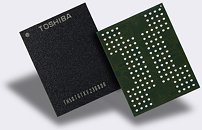Raevenlord
News Editor
- Joined
- Aug 12, 2016
- Messages
- 3,755 (1.15/day)
- Location
- Portugal
| System Name | The Ryzening |
|---|---|
| Processor | AMD Ryzen 9 5900X |
| Motherboard | MSI X570 MAG TOMAHAWK |
| Cooling | Lian Li Galahad 360mm AIO |
| Memory | 32 GB G.Skill Trident Z F4-3733 (4x 8 GB) |
| Video Card(s) | Gigabyte RTX 3070 Ti |
| Storage | Boot: Transcend MTE220S 2TB, Kintson A2000 1TB, Seagate Firewolf Pro 14 TB |
| Display(s) | Acer Nitro VG270UP (1440p 144 Hz IPS) |
| Case | Lian Li O11DX Dynamic White |
| Audio Device(s) | iFi Audio Zen DAC |
| Power Supply | Seasonic Focus+ 750 W |
| Mouse | Cooler Master Masterkeys Lite L |
| Keyboard | Cooler Master Masterkeys Lite L |
| Software | Windows 10 x64 |
Not all news coming out of Toshiba is bad or somewhat bad. The Japanese giant still is one of the biggest players in the NAND semiconductor business, no matter the recent woes. Even more recently, though, Toshiba announced they had developed quadruple level cell NAND memory, which should improve density and, therefore, reduce the price/GB ratio on future consumer products, such as SSDs. However, each increase in the number of cell levels bring concerns regarding not only performance, but especially durability, since a higher number of states per cell increases the voltage steps that are applied to it (SLC NAND dealt with two voltage states, MLC with four, TLC with eight voltage states, and QLC will handle 16 of these.) This tends to make errors more common, and the cell's longevity to be compromised due to the amount of variation in its states, which means more powerful error correction techniques must be employed.


According to Toshiba, its 3D QLC NAND targets around ~1000 program/erase cycles, which is close to TLC NAND flash. This is considerably higher than the amount of P/E cycles (100 - 150) expected for QLC by the industry, which means the company has achieved what many thought difficult. Toshiba has begun sampling of its 3D QLC NAND memory devices earlier this month. everything points to mass production on late 2018, early 2019, though, which means we still have a long way to go until we see this technology implemented. This won't be the one to save us from escalating NAND prices; we'll have to look to other, more market and supply-and-demand based factors instead.
View at TechPowerUp Main Site


According to Toshiba, its 3D QLC NAND targets around ~1000 program/erase cycles, which is close to TLC NAND flash. This is considerably higher than the amount of P/E cycles (100 - 150) expected for QLC by the industry, which means the company has achieved what many thought difficult. Toshiba has begun sampling of its 3D QLC NAND memory devices earlier this month. everything points to mass production on late 2018, early 2019, though, which means we still have a long way to go until we see this technology implemented. This won't be the one to save us from escalating NAND prices; we'll have to look to other, more market and supply-and-demand based factors instead.
View at TechPowerUp Main Site
Last edited:







